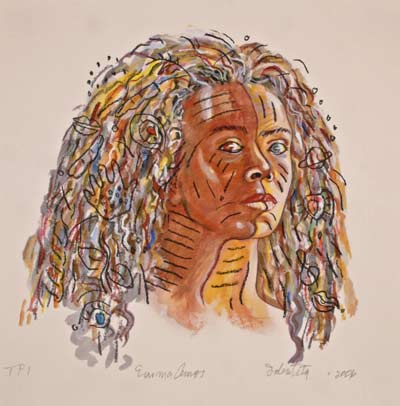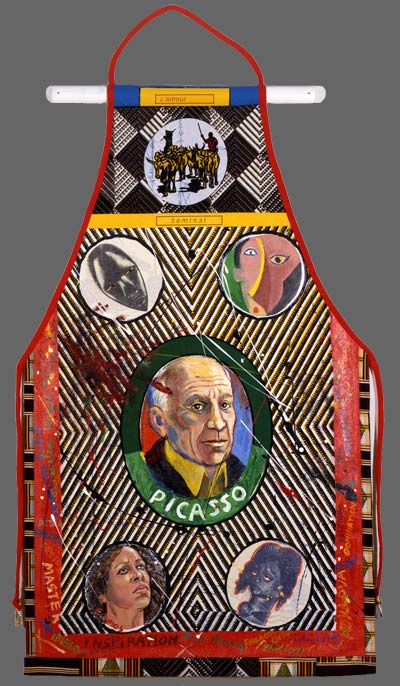In our Fall ’09 edition, THE POET’S EYE features Marian Cannon Dornell and Cheryl Clarke;
from Poetry Co-Editor Clare Coss.
Naomi’s Harvest By Marian Cannon Dornell
It’s spring in Fort Hunter. The sun smears
magenta, orange, purple over the islands
in the Susquehanna behind this slave- a plain
stocky woman with black, black skin.
She’s dressed in striped wool that sets her apart
from the other slaves on the farm
who wear plain homespun against the chill.
Her colors match the wooly balls she hoards
on boards lining her cabin walls.
She is, after all, above all, a weaver.
After trudging part-way up Blue Mountain
she throws down her hoe onto the rocky trail
and wrestles aside the Golden Bough brush
that hides the clearing she’s made for her hush-hush
herb garden. Her mistress thinks she comes up here
to harvest plant parts for her wool dyes
but she’s already passed those source plants, whose buds
begin to swell: Bitter Dock, Bouncing
Bet, Bugleweed, Tetterwort scattered
throughout these woods. On this day, she’s come
to fetch parts of the Stinking Benjamin* plant whose tea
protects her from nighttime intrusions
of her master. She lifts the hoe to break
up the ground to the rhythm
of her rage. Her harvest of corms lurks
just beneath the earth. Now, the smell
of spring floats up in big puffs about her boots. The corms
sprawl like veined knuckles. She reaches
down to grab the bits of corm from the damp dirt
and holds them to her nose in hopes
that this time she’ll finally smell
the stench from them. But she doesn’t. She
has never smelled spring (anything) in this place.
The last thing she remembers smelling
(twenty years before at twelve) is the odor
of her own fear staining the shovel the slaver
hit her over the head with when she screamed
and tried to run after her mother in the slave
market in Philadelphia; and the last thing she remembers
of her mother is seeing her wriggling fingers (her hands
were in rusted cuffs chained behind her back) -the fingers
that had slowly etched the shapes of home
into the palms of her daughter’s hands all the way
across the ocean–traced them to the rhythm
of the boards creaking over their heads
In the stinking belly of the slave ship.
Nearly too weak to speak,
her mother traced and retraced a whispered prayer
to Ananse Kokuroko* into the palms of Naomi’s hands:
Sankofa adinkrahene nyame dua akoben osrane ne nsoromma
Fihankra sunsum dame-dame nyame biribi*
The only sounds from home she remembers
are the names of those shapes.
She doesn’t know what they mean
in English. Still, she hears her mother’s voice
as she sees the shapes of home in the tendrils of roots
clinging to the corms that she cannot smell Instead,
she smells the stench of the slave ship.
She packs up her roots, puts on her shawl,
places her hoe over her shoulder
and she turns to walk back
down the path as the full moon rises
over the darkening ridges on the west side
of the Susquehanna.
*Stinking Benjamin is a plant used in folk medicine to promote menstruation. Plant names from “Eastern/Central Medicinal Plants” by Steven Foster and James A. Duke, Houghton Mifflin, 1990 and “Magic and Medicine of Plants,” Inge N. Dobelis, Editor, Reader’s Digest Association, Inc. 1986.
*Ananse Kokuromo is the god of mythology in Ghanaian culture. From: “Contemporary Ghanaian Literature, Theater and Film,” edited by Kofi Anyidoho and James Gibbs.
*Names of Adinkra symbols from “Values of Adinkra Symbols” by Adolph H. Agbo, Ebony Designs and Publications, Independence Hall, UST, Kumasi, Ghana, 1999.

lithograph and digital print 12″ x 12″
Susquehanna Baptism, 1954 By Marian Cannon Dornell
Tucked in a troublesome valley a brown-skinned girl
daydreams on her front steps. Above her the cross
from St. Patrick’s blocks
out the sun. To the east, the Capitol dome
frustrates her outlook. She saunters a few streets
over to the Susquehanna, which flows
toward a larger thing, resigned. It surrenders
to the whims of business as usual. Tugged
coal barges skim its shivering skin.
On river’s bank, this brown-skinned girl
faces the western shore that excludes,
where captains of anthracite shield
their women and children
from the dark. The brown-skinned girl
scribbles wishes she tosses
into the water. Her scraps of dreams
drown like unwanted puppies. At dusk,
debutantes drift by on a flotilla of party boats
sending jeweled skipping stones of taunting light
toward the brown-skinned girl.
And river flows to a larger thing, resigned.
The girl dives into the water and swims
to a nearby island for a closer look at life
on the far shore. She views bridges that span
the river — portals that could carry
her to the forbidden shore but she senses
she can live a better life than those prisoners
of industry with grinning jockeys on their lawns.
So she weaves herself a raft
of new dreams and floats
to her own distant shore
moving toward a larger thing, resolved.
Marian Dornell received a 2009 Walker Scholarship to the summer program at the Provincetown Fine Arts Center in Provincetown, MA, where she studied with Kimiko Hahn. Committed to creating community with her poetry, she was invited to read her poetry at a public event called “A Journey to a Hidden African-American Cemetery” in Fort Hunter, PA earlier this year. She is currently working on a chapbook whose theme is slavery and its legacy.

acrylic, African commemorative fabric, linen 60″ x 32″
Between meditations on Washington, D.C. By Cheryl Clarke
i. washington
nineteen-forty, dunbar high school, playing piano
nineteen-fifty-nine, a desegregated glen echo.
ii. washington’s past is troubled
we put our memories in an order in which we can apprehend our pasts
meanwhile laura bush slurs langston hughes in a low tone
iii. tines in the road
That batterer Paul Laurence Dunbar walked through occasionally.
Duke Ellington painted signs
and marveled at Willie the Lion Smith.
Alain Locke went to Paris.
Mary Church Terrell started sit-ins.
iv. Brevard
walked on the balls of his feet, especially after being let outta jail for being disorderly in georgetown/d.c. and hannah, his wife, my aunt who’d had him locked up fanning herself on the front porch watching him approach. brevard was beloved of my mother in that 1920 daguerreotype, recently discovered in some old keepsakes of hannah’s after my mother’s death. her– aged 4 astride brevard’s motorcycle frowning into the camera him behind her holding her on the seat her hair disorderly– woulda shamed her even in rural north carolina. made me wonder, like alice walker, about a little girl around a yard full of grown men, even her beloved cousin among them, no woman in sight, least not in the daguerreotype but maybe holding the camera.
v. desire
eat me forever.
vi. book feet
narrative of a slave age of innocence house of mirth incidents in the life of a slave girl souls of black folk song of myself songs of innocence portrait of a lady light in august third life of grange copeland go tell it on the mountain a street in bronzeville moby dick native son invisible man mansfield park anna karenina another country the color purple the red and the black the street the english patient
absalom absalom beloved
vii.
hold my place.
i’ll be back.
Cheryl Clarke is the author of four books of poetry since 1982, a collected works of prose and poetry 1980-2005, “The Days of Good Loos,” and a book of critical writing on contemporary black poetry, “’After Mecca’: Women Poets And The Black Arts Movement. Her newest collection, “Corridors Of Nostalgia,” will be published in 2011. She still enjoys claiming to be a black lesbian feminist.
